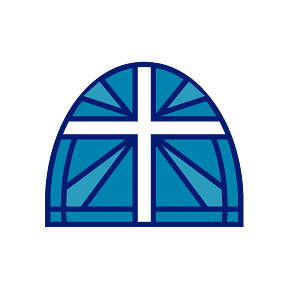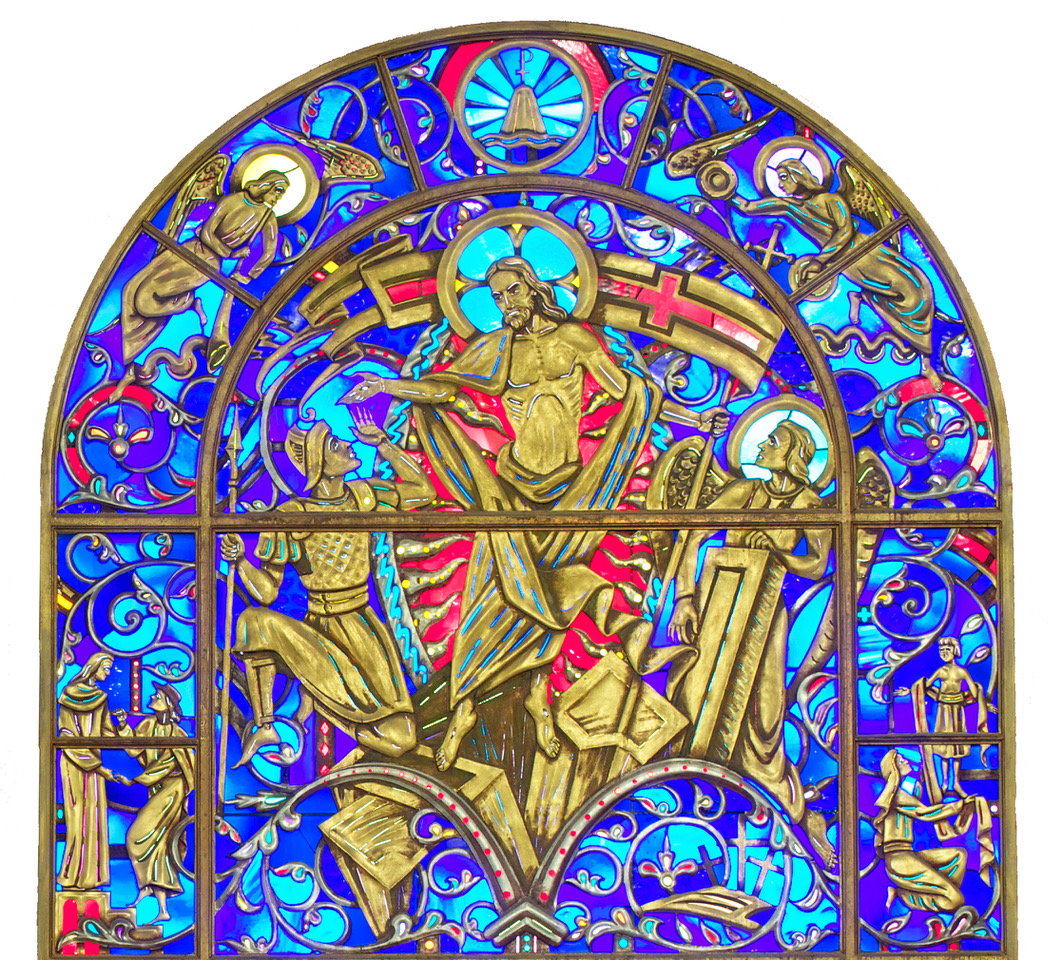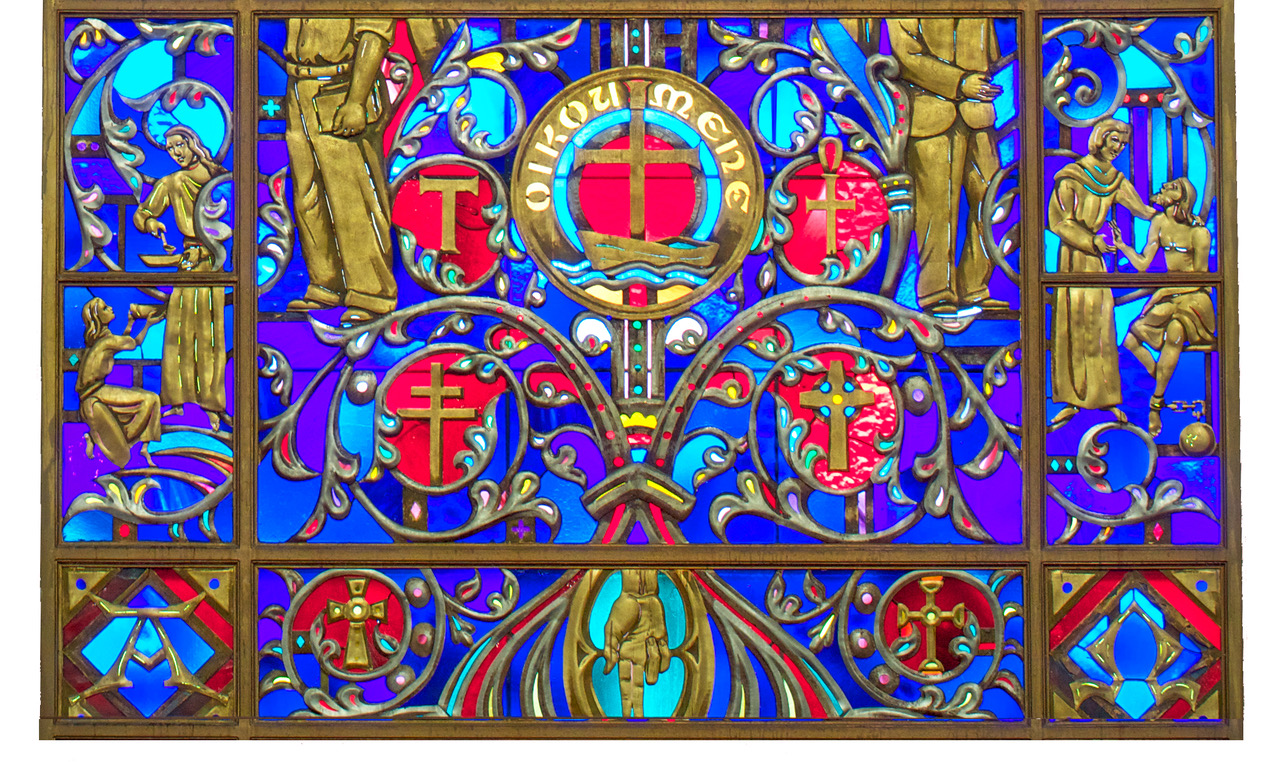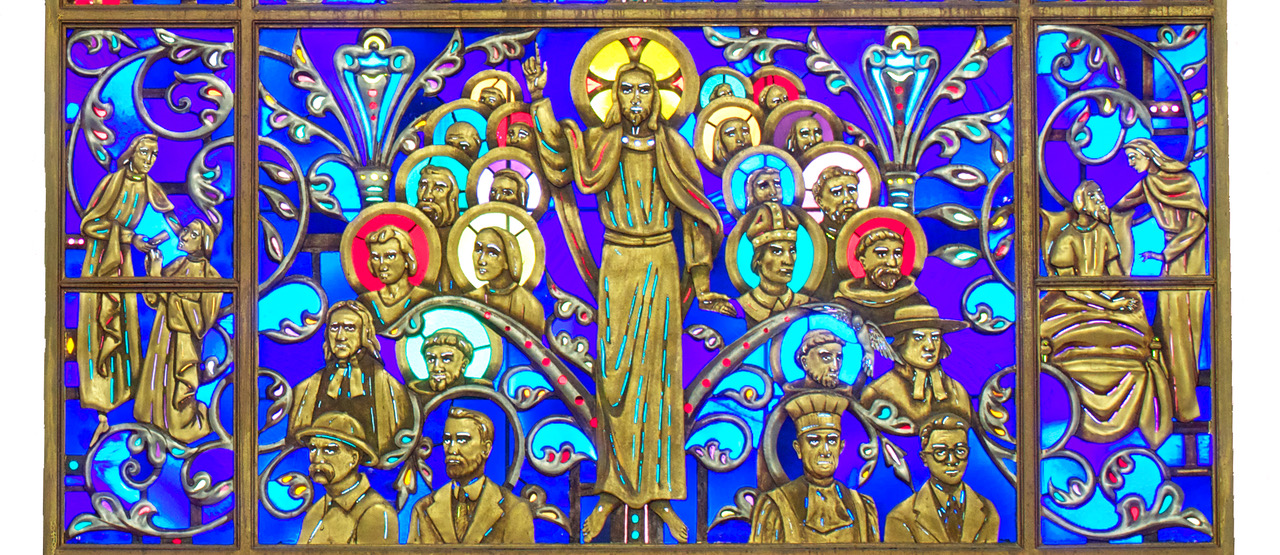The Chancel Window
The Opening Service for the new sanctuary at Dauphin Way United Methodist Church was March 17, 1957. The magnificent Chancel Window was the focal point. The window, known as the Adams-Little-McGowin Memorial Window, was given by the Lucius Geneve Adams family, the Joe Hollis Little family and Lillian Culpepper McGowin. When Catherine Keville Little was baptized in September 2002, she represented the fifth generation of the Adams charter family in Dauphin Way.
The Chancel Window was designed especially for the church by Dr. Henry Lee Willet of the internationally acclaimed Willet Stained Glass Studios of Philadelphia, Pennsylvania. The Dauphin Way window displays a technique developed by Willett Studios of adding sculptured sheet lead flown with gold and platinum leaf to colored glass thus producing a window glorious to behold at night as well as day.
The Chancel Window has been called an “Ecumenical Window” because of those pictured and because of the Ecumenical Seal in the lower part of the window. Dauphin Way’s senior minister at the time, Dr. A. Carl Adkins, attended the Second Assembly of the World Council of Churches in Evanston, Illinois in 1954. This was reported to be the most important religious event ever to be held on American soil; there were delegates representing 200 million people from 48 countries. The theme was “Christ, the Hope of the World,” reflecting both the ecumenical spirit and the unity of the Christian Church in a world recently divided by war. The opening service of the Assembly was held in First Methodist Church, Evanston, Illinois, where Dr. Harold A. Bosley was the minister. Dr. Bosley was asked to be a consultant to Willet Studios on the Dauphin Way window and was later invited to preach at Dauphin Way. The ecumenical experience of the 1954 Assembly must have indeed confirmed in Dr. Adkins’ mind the desire for an ecumenical theme for the Chancel Window.
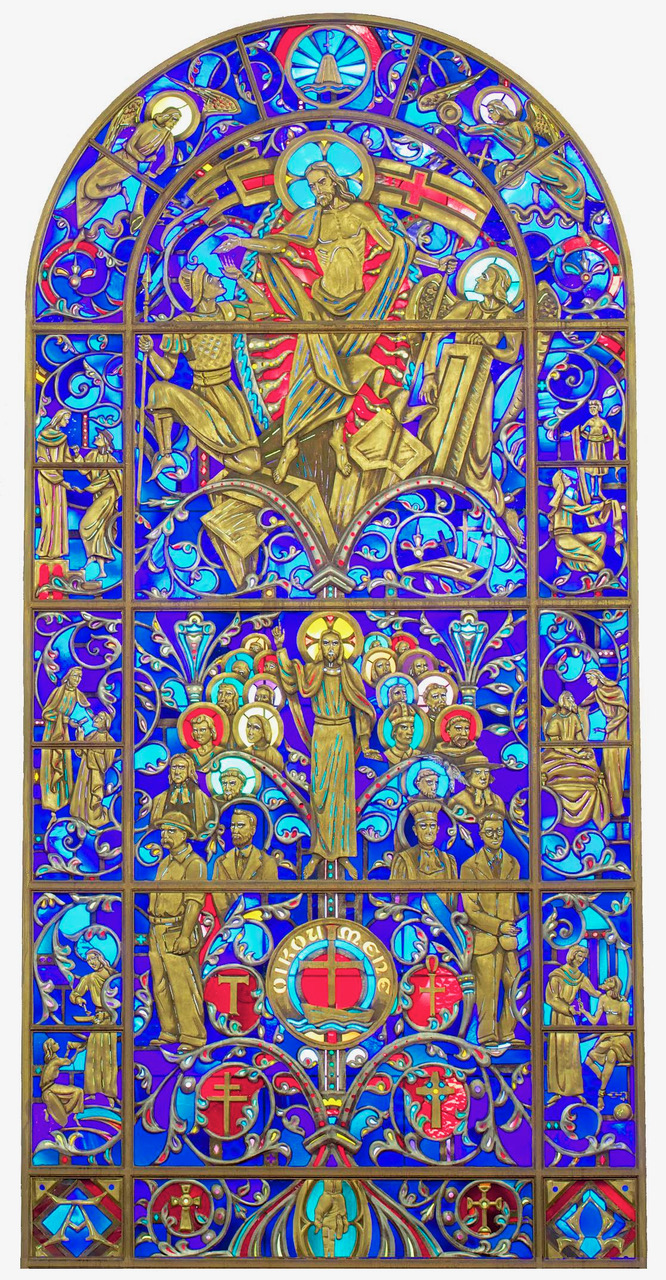
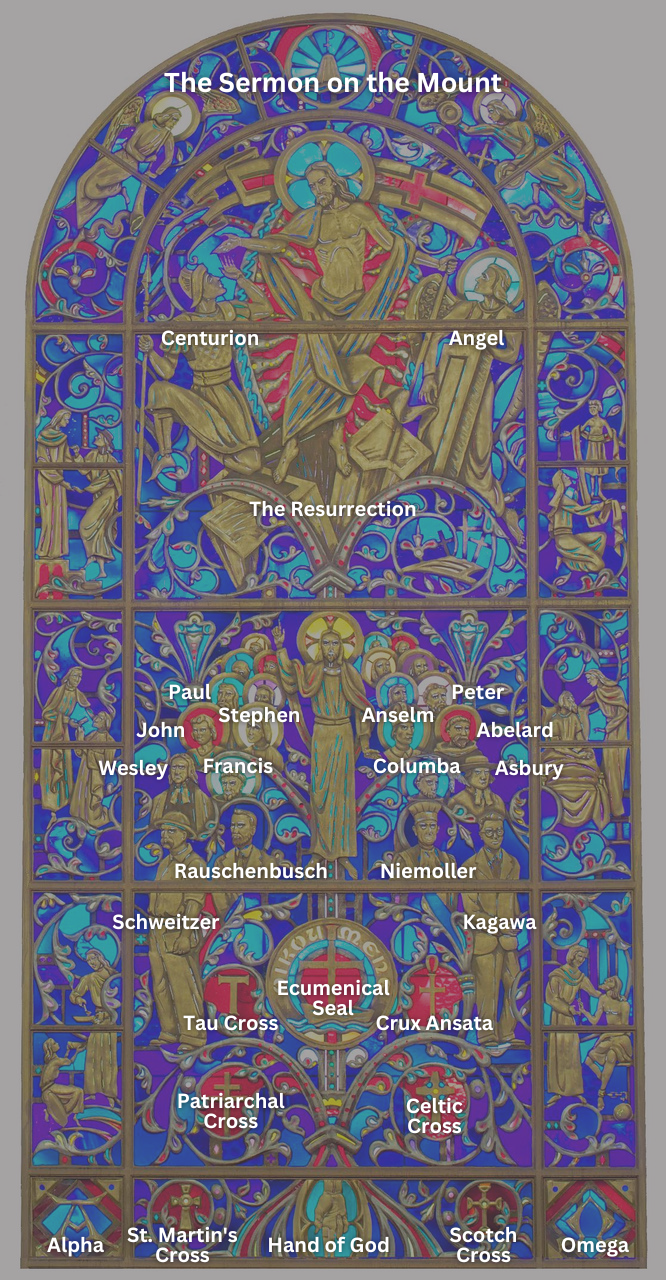
Resurrection is the primary focus of the Chancel Window and the central theme of the Christian Faith. To the left of the Risen Christ, the kneeling Roman soldier is shielding his eyes from the glory of Christ’s presence. The angel on the right is rolling away the stone. Jesus is holding the banner of the cross floating behind his head. High above on either side are two angels celebrating the resurrection.
Encircled at the top of the window, positioned on top of a mountain is the Chi Rho (XP – the first two letters of the word “Christ” in Greek) symbolizing the Sermon on the Mount. The Sermon on the Mount (Matthew 5:1 – 7:29) is a summary of the message of Christ.
At the bottom corners of the window are the Alpha and Omega, the first and last letters of the Greek alphabet. In Revelation 22:13, Jesus says, “I am the Alpha and the Omega, the first and the last, the beginning and the end.”
In the bottom center of the window is the Hand of God (Manus Dei) reaching down in loving benediction. The hand is extended downward with the thumb and two fingers open offering the Trinitarian Benediction. The roots of The Tree of Life surround the Hand of God.
Around the outside of the window are six scenes from The Final Judgment. These “Acts of Mercy” illustrate why the righteous will be chosen in the final judgment.
Beginning at the bottom left and moving up: I was hungry and you gave me food, I was thirsty and you gave me drink, I was a stranger and you welcomed me,
Then moving down from the top right: I was naked and you clothed me, I was sick and you visited me, I was in prison and you came to me.
The Ecumenical Seal, representing the inclusiveness of the Christian Faith, is shown as a circle enclosing a ship with the words Oikoumene above. The ship is an early symbol for the Church. The Latin word for ship is nave. The nave of the sanctuary is the central seating area. In the nave we learn the gospel and from the nave take the gospel into all the world. The mast of the ship is a Latin Cross, showing the Church conveys and protects the Good News.
Oikoumene is the Greek word for the inhabited world. Clement of Rome, martyr and Bishop of Rome 88-97 AD, said: “For the whole business of the Church is like unto a great ship, bearing through a violent storm men who are of many places, and who desire to inhabit the good kingdom.”
The Ecumenical Seal is framed by Six Christian Crosses in pyramid form. Beginning on the top left, The Tau Cross (resembles the 19th letter of the Greek alphabet – Tau). The Patriarchal Cross has an upper arm representing the inscription placed on the cross of Jesus, “Jesus of Nazareth, King of the Jews.” Saint Martin’s Cross is a variation of the Celtic Cross without the circle. From the top right, The Crux Ansata is a cross derived from the Egyptian ankh, a symbol for life, and used by the early Coptic Christians. The Celtic Cross, or the Cross of Iona, was used by Irish missionaries, the circle representing the eternal redemption of Christ. The Scotch Cross is a variant of the Celtic Cross.
The Great Commission is pictured in the lower half of the window. Christ is shown sending his disciples into the world: “Go ye therefore, and make disciples of all nations…” The Body of Christ forms the trunk of the Tree of Life, whose branches extend upward and outward. The window is laced throughout with leafy branches representing the countless followers of Christ, “I am the vine, ye are the branches.” (John 15:5)
Nearest Christ are the disciples of his own day and then, through the ages, other Christian leaders are pictured as a great procession reaching from Biblical times until it reaches our own generation. In 1957, when this window was installed, three of those pictured were still living: Albert Schweitzer, Toyohiko Kagawa, and Martin Niemoller. (Kagawa and Niemoller, prominent Japanese and German Christians, also attended the conference in Evanston.)
There are eleven figures to the left of Christ and twelve on His right, twenty-three figures all together. Fourteen of the figures are recognizable and only four of those are Biblical. Peter and John are pictured here and behind them are the other nine of the original disciples; Judas is not pictured.
On the front row, beginning on the left is Albert Schweitzer, Walter Rauschenbusch, Martin Niemoller and Toyohiko Kagawa. Behind them on the second row are John Wesley, St. Francis of Assisi, St. Columba and Francis Asbury. On the third row from the left, are the first Biblical characters St. John, St. Stephen, then over on the right St. Anselm and Abelard. On the fourth row two figures are identifiable–St. Peter and St. Paul–and behind them the other nine disciples.
The psychiatrist Elisabeth Kubler-Ross said, “People are like stained-glass windows. They sparkle and shine when the sun is out, but when the darkness sets in, their true beauty is revealed only if there is light from within.”

